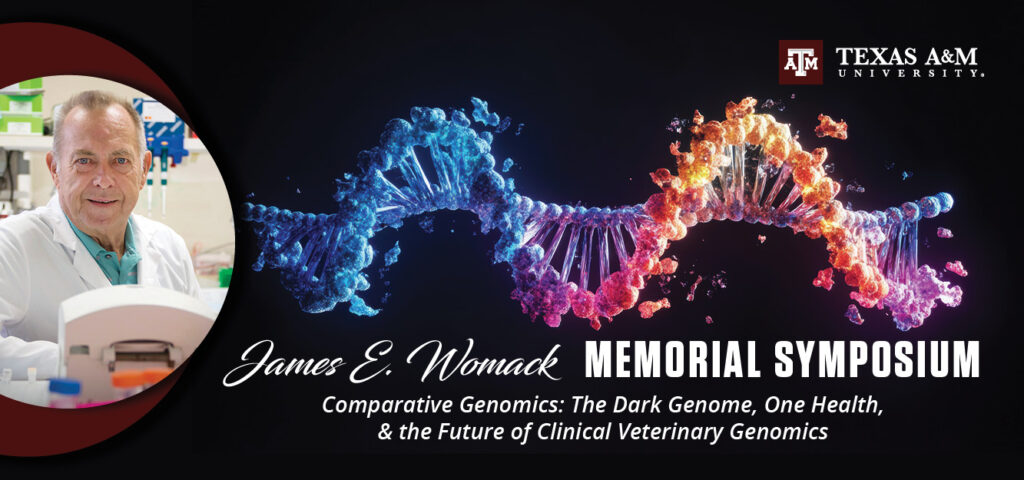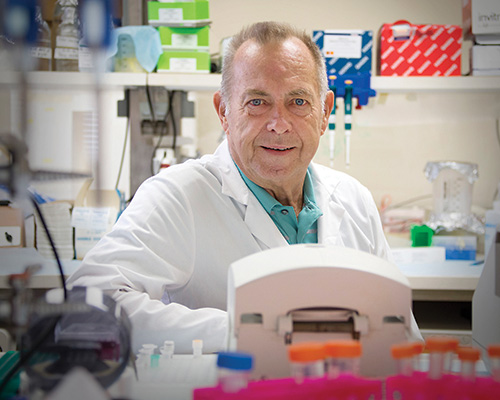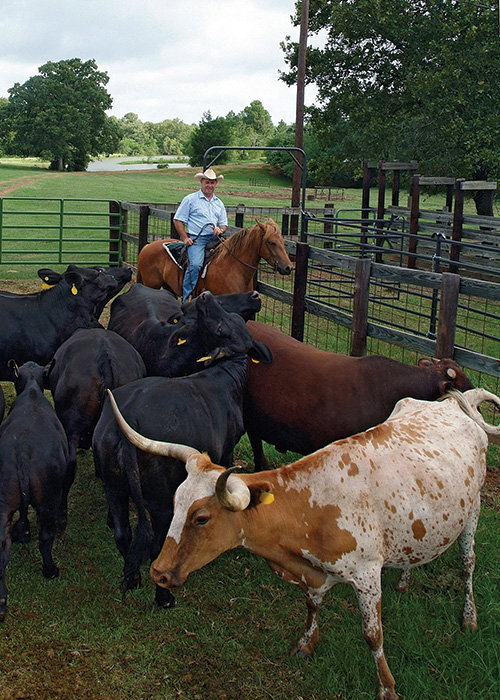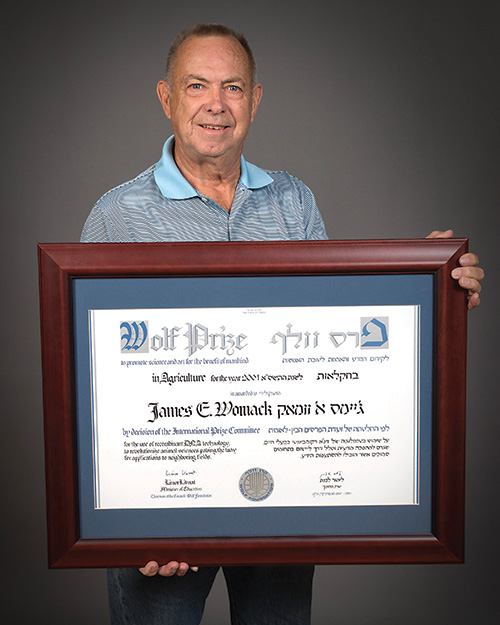
The following is a retrospective of Dr. Womack’s career taken from CVM Impact, a special publication about research at the Texas A&M College of Veterinary Medicine & Biomedical Sciences (VMBS), published in the Fall of 2016.

IN-GENE-IOUS: A Man with a Plan
Story by Dr. Megan Palsa, CVM Communications
Dr. James Womack, distinguished professor in the Department of Veterinary Pathobiology, researches inherited resistance to disease in certain animals—both individual animals and breeds. For example, certain cattle have evolved a stronger defense against bacterial and viral pathogens. Womack wants to understand the genetics behind this because it could allow breeders to develop a healthier herd. This is the topic of his most recent USDA-funded research project.
Bovine respiratory disease is the most common and costly disease affecting the North American cattle industry. “Not all cattle respond to bovine respiratory pathogens the same, and we’re trying to develop a DNA chip where a little bit of DNA can determine the relative susceptibility or resistance of a particular animal to respiratory disease,” Womack said.
Womack and his team of researchers have identified some genes and clusters of genes that convey resistance, and although they are still being validated with additional
studies, they have begun to publish the data. Their goal is to give dairy and beef cattle breeders a tool, the DNA chip, to help determine if an animal is resistant to bovine respiratory pathogens. “We want to be able to look at the DNA chip and say we want to breed this individual, and this one will have offspring that are more resistant,” he said.
Womack’s research isn’t restricted to cattle; he has worked extensively with mice as well as chickens. He has spent time in Korea studying chickens with the same goal—finding genes that confer disease resistance. Recently, he studied a gene in rats that allows the rats to be resistant to Rift Valley fever, a disease that has taken a toll in Africa and affects cattle, sheep, and goats. “We found a rat model for it and identified that gene,” Womack said. “We occasionally work with dogs, cats, pigs, and horses, too.”
Most of Womack’s research has taken place right here in College Station. He said he “got a good start” in research at the Jackson Laboratory, but he was able to continue his work in his current position. “I was very interested in the evolution of animal genomes, how the mouse genome compared to the human genome, and what the differences are between them. When I got here, I expanded my research into the cattle genome. My work is kind of comparative genomics, I guess, and how these little subtle differences seemed to make a difference and why cattle have more genes related to immune function than other mammals,” he said.
WOMACK HAS BEEN PART OF THE TEXAS A&M FAMILY FOR 39 YEARS.
The distinguished professor, a designation he has held since 2001, has a joint appointment in the Department of Molecular and Cellular Medicine at Texas A&M’s College of Medicine and the Department of Veterinary Pathobiology. He was promoted to professor in 1983, and two years later received the W.P. Luse Endowed Professorship. From 1989 to 1996, he was director of the Center for Animal Genetics at the Institute of Biosciences and Technology, and he was named interim associate department head for the Department of Veterinary Pathobiology from 1990 to 1993.

Impacting Students
Womack noted that his students have been a large part of the success he’s enjoyed in research. His 50th doctoral student recently defended her dissertation, and he has had a myriad of master’s students as well.
“We have a genetics graduate program here, and we have 10 or 12 students every year admitted to that program,” he said. “They apply from all over the country. We also have international students here who know about our program, maybe from professors in China or Korea, who also contact us.”
In fact, it was one of his former students, now a professor at Washington State University, who contacted him regarding the USDA Bovine Respiratory program. “Then, another fellow, whom I had worked with before at The University of Missouri, and a group at the University of California, Davis—we all just got together and said, ‘Let’s put one of these big grants together.’” They nominated Womack as their project leader.
Womack continues to love and be inspired by teaching undergraduate students. “These are juniors and seniors, and they’re usually applying to medical schools, veterinary colleges, and graduate schools. I write a lot of letters, and then they stay in touch with me. I enjoy that. My students kind of become like my children.”
Collaboration
Being next to the break room, Womack said many “coffee pot discussions” take place outside his office. “I usually leave my door open, and the coffee pot’s right out there. I have a lot of people coming by.” A lot of those people coming by are fellow researchers. He said it’s valuable and interesting to learn about others’ research and that some things that seem unrelated can actually shed light on other topics.
Spending time with other faculty members and researchers is important to Womack and his research. He often sits down to learn from and brainstorm with his colleagues across the college. “We’ve come to realize that this fast-paced world requires strong partnerships to leverage creativity, experience, and resources. With unique thinkers, we can help one another generate ideas—and possibly arrive at viable solutions in less time,” said Womack.

Honored by His Peers
Although his list of honors is lengthy, there is one award of which Womack is most proud.
It’s the Wolf Prize in Agriculture, which he received in 2001 for his “use of recombinant DNA technology to revolutionize plant and animal sciences, paving the way for applications to neighboring fields,” according to the Wolf Foundation, which awards the prize.
The Wolf Prize in Agriculture is awarded annually in Israel. One of six such prizes established by the Wolf Foundation, the Wolf Prize in Agriculture is considered by many to be the Nobel Prize within the field of agriculture.
Prior to that honor, in 1999, he was named to the U.S. National Academy of Sciences (NAS). This organization recognizes and promotes outstanding science through election to its membership, publication in its prestigious journal, and its awards, programs, and activities.
Election to the NAS is considered one of the highest honors a scientist can receive. Today, there are approximately 2,250 members and nearly 440 foreign associates, of whom approximately 200 have received Nobel prizes.
Womack’s other honors include the Bush Excellence Award for Faculty in International Research, Texas A&M University, 2008; Dean’s Impact Award, College of Veterinary Medicine, Texas A&M, 2007; Outstanding Alumnus of the Year, Abilene Christian University, 2006; Distinguished Service Award, Texas Genetics Society, 2006; Fellow, American Association for the Advancement of Science, 1999; Outstanding Texas Geneticist, Texas Genetics Society, 1996; CIBA Prize for Research in Animal Health, 1993; McMaster Fellow, CSIRO, Australia, 1990; Carrington Award for Research in Cell Biology, 1990; Faculty Distinguished Achievement Award for Research, Texas A&M University, 1987; and the Alumni Citation Award, Abilene Christian University, 1983.
He serves or has served on editorial boards for these publications: Genomics, Journal of Heredity, Biochemical Genetics, Animal Genetics, Mammalian Genome, Genome Research, and Animal Biotechnology.
About the Symposium
The James E. Womack Memorial Symposium was co-sponsored by the following Texas A&M entities:
